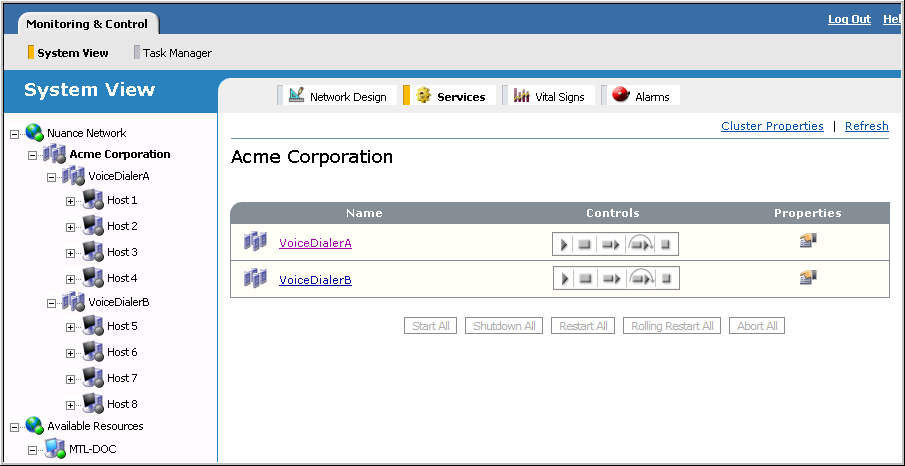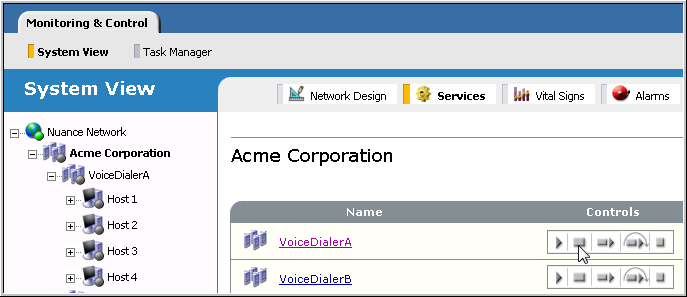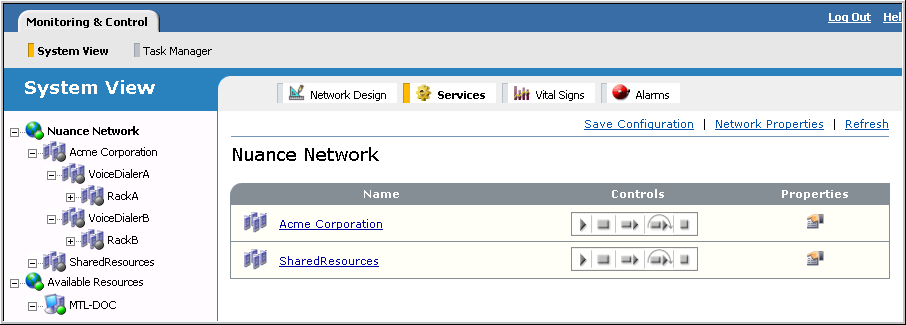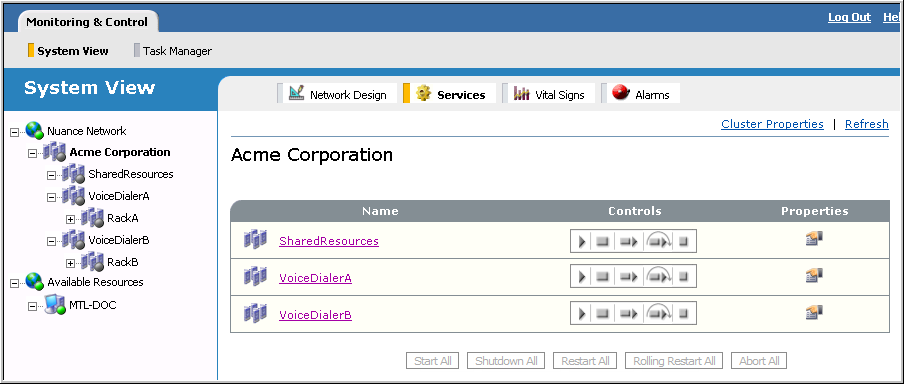Starting and stopping services
Use the control icons or “All” buttons at the bottom of the page to control services:
- Start services.
- Shut down services. The shutdown is graceful: services stop accepting new connections, and wait for any active connections to complete before shutting down. For example, you would shut down services before an upgrade to the operating system on any host.
- Restart services. Services are shut down then started.
- Rolling restart. By default, the Management Station restarts services across all hosts. With the rolling restart function, services are restarted on each host, one after the other. This feature is only available when you define clusters. See Parallel service control.
- Abort services. The services and any active connections stop immediately.
Note: Starting and stopping services is different than starting and stopping all Speech Suite processes. To shut down the entire system, stop the services, stop Management Station, and stop Watcher service. See the related links at the bottom of this page for details.
These operations are available at the cluster, host, and service scopes. At the highest scope (cluster), the action is performed on all services across all hosts. For example, say a cluster contains two child clusters, each with several hosts running services in a distributed environment. A Start All at the parent cluster starts all the services on the hosts in both child clusters. For example:

If you navigate to the lowest scope (service), the action is performed only on that service.
Note: The All buttons at the bottom of the page (Start All, Shutdown All, and so on) aren’t available at the Nuance Network scope to prevent someone from inadvertently bringing down the network.
At the service scope, the control icons are active or inactive depending upon the state of the service. Hold the mouse over a VCR control to display its action. If a service is stopped, then only the start control is active. If the service is ready, the start control is inactive, and the other controls are active. (If the service is offline, you need to go back to Network Design and assign a physical host.)
As a service goes from one state to another, it goes through temporary states like starting, connecting, initializing until it reaches the final state (ready or stopped). A window appears indicating the progress. Once the operation successfully finishes, the window closes.
Troubleshooting: if the Resource Manager fails to start on a Linux system, the cause might be related to permissions. See Resource Manager or NTpE fails to start on Linux.
Start and stop order
The Management Station automatically starts and stops services in a certain order to ensure that your system is ready to take calls before interacting with the caller. For example, it starts the Nuance Resource Manager service before the Speech Server. It stops services in the reverse order as well, for example, stopping the Speech Server before the Nuance Resource Manager service, and so on.
By default, when hosts are grouped in clusters, the Management Station starts and stops services in order across all hosts until all services are started. To configure the Management Station to start and stop services by host, see Parallel and sequential service control.
Autonomous clusters
If your network consists of independent, autonomous clusters, you can use the “All” buttons (for example, Start All, Shutdown All, and so on) and the Management Station handles the correct order for you. For example, this network contains several grouping clusters with the lowest-level clusters containing the physical hosts:

A Start All on the parent Acme Corporation cluster starts the services in the correct order on all hosts in all clusters. The clusters and hosts are locked during the operation and are unlocked after all services have successfully started.
Because the clusters are autonomous, you can perform service-control operations on any cluster. For example, you can keep the VoiceDialerA cluster in service and bring down the VoiceDialerB cluster for maintenance. To do this, you would use the “cluster shutdown all” control icon. For example:

Shared-resources clusters
When your clusters contain shared resources (for example, application server or Speech Server hosts), start them first (and stop them last) to avoid alarms and undesirable behavior. This avoids situations where the system accepts calls before an application service or Speech Server is running.
If all clusters are grouped under a parent cluster, the Management Station starts everything in the correct order when you perform an All function on the parent cluster. But if your shared-resources clusters are at the same level as your other clusters or at are at a higher level in the network hierarchy, you have to start the shared-resource cluster first.
This network example shows two top-level clusters: the parent Acme Corporation cluster containing several child clusters, and the SharedResources cluster.

Because the child clusters depend on the shared resources, you must start the SharedResource cluster first. Just click the “cluster start all” control icon.
Now notice what happens when you group all clusters under the parent Acme Corporation cluster like this:

Now you can just click Start All for the entire Acme Corporation cluster and the Management Station starts all services, including the shared resources, in the correct order. The same holds true with a Shutdown All. Only if you navigate to one of the child clusters would you need to start the shared resources first.
This arrangement of grouping all clusters within a parent cluster is the simplest way to organize clusters when sharing resources. It eliminates the complexity of having to remember the correct start and stop order.
